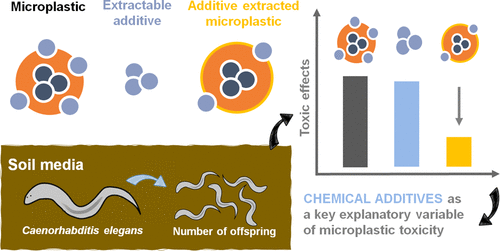当前位置:
X-MOL 学术
›
Environ. Sci. Technol.
›
论文详情
Our official English website, www.x-mol.net, welcomes your
feedback! (Note: you will need to create a separate account there.)
Effects of Different Microplastics on Nematodes in the Soil Environment: Tracking the Extractable Additives Using an Ecotoxicological Approach
Environmental Science & Technology ( IF 10.8 ) Pub Date : 2020-10-14 , DOI: 10.1021/acs.est.0c04641 Shin Woong Kim 1, 2, 3 , Walter R Waldman 4 , Tae-Young Kim 5 , Matthias C Rillig 1, 2
Environmental Science & Technology ( IF 10.8 ) Pub Date : 2020-10-14 , DOI: 10.1021/acs.est.0c04641 Shin Woong Kim 1, 2, 3 , Walter R Waldman 4 , Tae-Young Kim 5 , Matthias C Rillig 1, 2
Affiliation

|
With increasing interest in the effects of microplastics on the soil environment, there is a need to thoroughly evaluate the potential adverse effects of these particles as a function of their characteristics (size, shape, and composition). In addition, extractable chemical additives from microplastics have been identified as an important toxicity pathway in the aquatic environment. However, currently, little is known about the effects of such additives on the soil environment. In this study on nematodes (Caenorhabditis elegans), we adopted an ecotoxicological approach to assess the potential effects of 13 different microplastics (0.001–1% of soil dry weight) with different characteristics and extractable additives. We found that poly(ethylene terephthalate) (PET) fragments and polyacrylicnitrile (PAN) fibers show the highest toxicity, while high-density polyethylene (HDPE), polypropylene (PP), and polystyrene (PS) fragments induced relatively less adverse effects on nematodes. In addition, low-density polyethylene (LDPE) induced no toxicity within our test concentration range for the acute period. Acute toxicity was mainly attributed to the extractable additives: when the additives were extracted, the toxic effects of each microplastic disappeared in the acute soil toxicity test. The harmful effects of the LDPE films and PAN fibers increased when the microplastics were maintained in the soil for a long-term period with frequent wet–dry cycles. We here provide clear evidence that microplastic toxicity in the soil is highly related to extractable additives. Our results suggest that future experiments consider extractable additives as key explanatory variables.
中文翻译:

不同微塑料对土壤环境中线虫的影响:使用生态毒理学方法追踪可提取添加剂
随着人们对微塑料对土壤环境影响的兴趣日益浓厚,有必要根据这些颗粒的特性(尺寸、形状和成分)来彻底评估其潜在的不利影响。此外,微塑料中可提取的化学添加剂已被确定为水生环境中的重要毒性途径。然而,目前人们对此类添加剂对土壤环境的影响知之甚少。在这项关于线虫(秀丽隐杆线虫)的研究中,我们采用了生态毒理学方法来评估 13 种具有不同特性和可提取添加剂的不同微塑料(土壤干重的 0.001-1%)的潜在影响。我们发现聚对苯二甲酸乙二醇酯(PET)碎片和聚丙烯腈(PAN)纤维表现出最高的毒性,而高密度聚乙烯(HDPE)、聚丙烯(PP)和聚苯乙烯(PS)碎片对线虫的不利影响相对较小。此外,低密度聚乙烯(LDPE)在我们的急性期测试浓度范围内没有引起毒性。急性毒性主要归因于可提取的添加剂:当提取添加剂时,每种微塑料的毒性作用在急性土壤毒性试验中消失。当微塑料在土壤中长期存在且频繁的干湿循环时,LDPE 薄膜和 PAN 纤维的有害影响会增加。我们在这里提供了明确的证据,表明土壤中的微塑料毒性与可提取的添加剂高度相关。我们的结果表明,未来的实验将可提取的添加剂视为关键的解释变量。
更新日期:2020-11-03
中文翻译:

不同微塑料对土壤环境中线虫的影响:使用生态毒理学方法追踪可提取添加剂
随着人们对微塑料对土壤环境影响的兴趣日益浓厚,有必要根据这些颗粒的特性(尺寸、形状和成分)来彻底评估其潜在的不利影响。此外,微塑料中可提取的化学添加剂已被确定为水生环境中的重要毒性途径。然而,目前人们对此类添加剂对土壤环境的影响知之甚少。在这项关于线虫(秀丽隐杆线虫)的研究中,我们采用了生态毒理学方法来评估 13 种具有不同特性和可提取添加剂的不同微塑料(土壤干重的 0.001-1%)的潜在影响。我们发现聚对苯二甲酸乙二醇酯(PET)碎片和聚丙烯腈(PAN)纤维表现出最高的毒性,而高密度聚乙烯(HDPE)、聚丙烯(PP)和聚苯乙烯(PS)碎片对线虫的不利影响相对较小。此外,低密度聚乙烯(LDPE)在我们的急性期测试浓度范围内没有引起毒性。急性毒性主要归因于可提取的添加剂:当提取添加剂时,每种微塑料的毒性作用在急性土壤毒性试验中消失。当微塑料在土壤中长期存在且频繁的干湿循环时,LDPE 薄膜和 PAN 纤维的有害影响会增加。我们在这里提供了明确的证据,表明土壤中的微塑料毒性与可提取的添加剂高度相关。我们的结果表明,未来的实验将可提取的添加剂视为关键的解释变量。






























 京公网安备 11010802027423号
京公网安备 11010802027423号